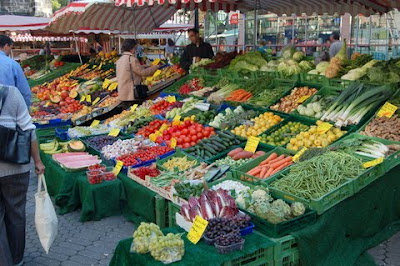One thing my wife and I like to do when we travel is to visit the stores and markets to see what types of foods are native to the area we visit. We typically purchase food for lunch (sometimes for breakfast and dinner) that we can eat as a picnic. We have encountered some beautiful displays and quite a few shops with things we think are strange, to the locals are normal.
These photos are of a cheese shop on the Rue Clair in Paris France. The cheeses are molded into all kinds of shapes: pyramids, cylinders, bricks, cones and more. Most of the cheeses have a nice mold covering. The soft cheeses like cream cheese are in a large vat and sold in bulk according to weight. We didn’t sample any of these cheese though during our travels we have eaten some moldy cheeses on cheese plates that sometimes follow dinner.
Most candy and pastry shops offer a much wider array of products then you find in the states. These are not mass produced products encased in plastic with lots of preservatives, but products made on-site with a wonderful fresh flavor.
We always like to take pictures of unique foods that we encounter, the hedgehog candies are one example. Another example is the women’s breasts that we saw in Bruges. Do you suppose they have a mold to make those? We didn’t go in to ask.
Meat products are handled differently than the states, while there are some supermarkets (Large European supermarkets would be considered small in the states), most of the food is sold through small shops that specialize in a specific product. In these photos, a side of beef is delivered in the morning to a shop and a display of ducks complete with the head (so they can smile at you).
While their supermarkets are smaller, they typically have a better and wider offering of products than grocery stores where we shop. When we travel we like to have yogurt in the morning, many of the yogurts in the states have about the same consistency and flavor with lots of added sugar. The yogurts in Europe have a creamier texture with a more refined taste and without a lot of the added sugar.
One thing that initially takes some getting used to, is pricing your own produce. After placing produce in a bag, you take it to a scale and select the appropriate product button (they use photographs so you don’t need to worry about reading a name), and place the printed label on the bag before heading to the check stand.
Larger cities do have a large market that consists of fifty to one hundred (or more) small individually owned and operated booths. The booths are segregated by the type of food; poultry, dairy, produce, meat, etc.
Towns also have outdoor markets that depending on the size of the town, have different intervals from once a week to everyday (except Sunday). The outdoor market stalls typically have beautiful displays of their products. I have found that many of my most colorful photos were taken at these outdoor markets.
No matter where you purchase food; small shop or supermarket, shopping in Europe is usually a fun adventure.
Adventures In Food: Author: Kerry Howell
Sunday, June 13, 2010
Subscribe to:
Post Comments (Atom)



















No comments:
Post a Comment